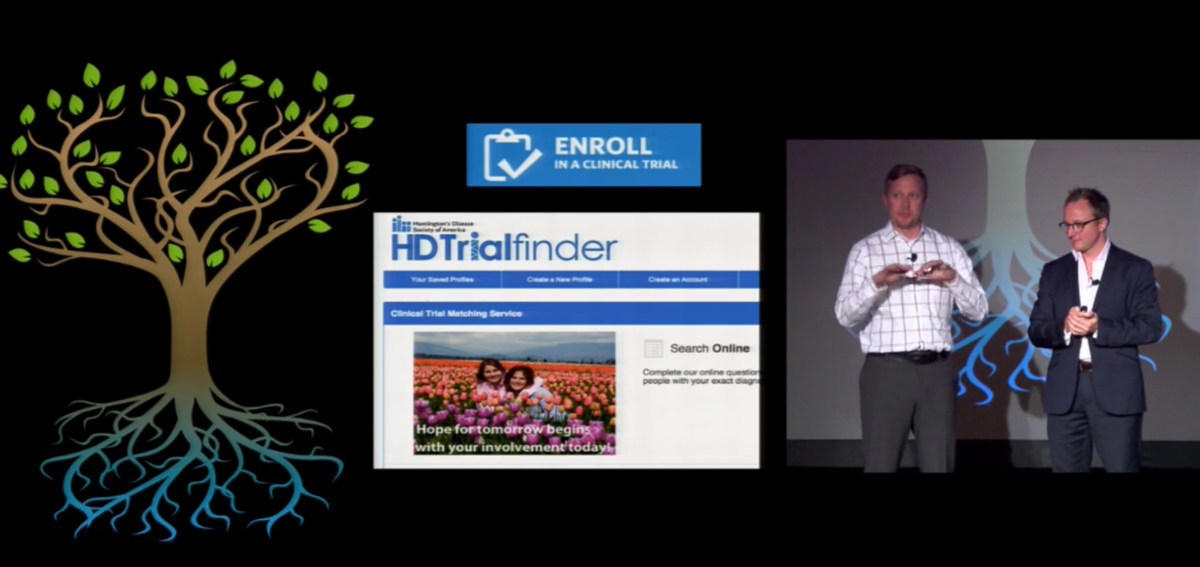Planting trees together: The 2016 Huntington's Disease Society of America Convention
HDBuzz summarizes the science from an unusually large and energized @HDSA convention in Baltimore
 By Dr Jeff Carroll June 13, 2016 Edited by Dr Jeff Carroll
By Dr Jeff Carroll June 13, 2016 Edited by Dr Jeff Carroll
Nearly a thousand HD family members converged on Baltimore, Maryland for the 2016 Huntington’s Disease Society of America’s Annual Convention. We normally don’t write reports from patient and family conferences, but there was something special about the atmosphere of this year’s Convention that compelled us to pen a brief update.
The Convention
This was the second-biggest convention in the HDSA’s history, and HDBuzz co-founders Jeff and Ed were there to talk science. You can see a video of our presentation on YouTube and hear the audio in the latest edition of our podcast, HDBuzzCast. Many of the other talks are featured on the HDSA website.
Clinical trials
According to the Huntington Study Group’s HD Insights Publication, there are currently thirteen clinical trials recruiting or in progress in Huntington’s disease, some of which are testing treatments specifically designed with HD in mind, rather than drugs thought to be generally good for brains. This is an incredible time for HD families.

Two trials we’ve been watching closely had important updates. The Teva PRIDE-HD study of pridopidine, a new drug to treat movement problems in HD, is fully recruited. The same is true of Pfizer’s Amaryllis study of their PDE-10 inhibitor drug that aims to improve communication between neurons. Delivering efficient trial recruitment is great news and a testament to the ability of the HD community to rise to the challenge.
There is no room for complacency though. We need to recruit all active trials as quickly as possible. Teva’s Legato-HD study of laquinimod, for example, is testing a drug that it’s hoped will slow the progression of Huntington’s disease but still needs more volunteers. The same is true of several other trials.
Good news from the ‘gene silencing’ trial
Ed Wild gave an update on the trial of Ionis-HTTRx, the first ‘gene silencing’ or ‘huntingtin-lowering’ drug that’s ever been tested in human HD patients. Speaking on behalf of the sponsor, Ionis Pharmaceuticals, Ed reported that the trial began in September 2015 and that 5 clinical sites are now up and running. In an exclusive HDSA update, he announced that there have been no safety issues with the drug so far, and the trial’s independent safety committee had just approved the start of the third of four dosing levels. This is the best news we could have expected at this stage in the trial, and we eagerly await further updates.
Where do I sign up?
How can HD-impacted people get into a clinical trial? In the US and Canada, the answer is HDSA’s TrialFinder system. You enter a few basic details and within a minute you will see a customized list of what studies you may be eligible for in your area, with links to the research teams.
What if I’m not eligible?
Clinical trials can be hard to get into because each one has strict criteria for who’s eligible and who’s not. If you find there’s no drug trial near you that you’re able to take part in, don’t lose heart. Here’s our 3-step plan for finding the silver lining.
“We need to recruit all active trials as quickly as possible. ”
- Sign up for Enroll-HD, a platform for understanding HD and a database for recruitment into future clinical trials. Virtually all HD family members are eligible, even people who haven’t had a genetic test.
- Be a trial wingman: spread the word about trials and research on Social Media and in person to your friends and family. Can you volunteer to help someone else be in a trial, by accompanying them to appointments or helping them complete trial activities?
- Take part in observational studies – that’s HD research that doesn’t involve testing new treatments. These studies are essential because they help bring about the next generation of treatments and trials.
Innovation
Although the HDSA convention isn’t a science meeting, we were surprised by the amount and quality of innovative new projects we heard about there. Our personal highlights were:
- CHDI Foundation linking up with IBM’s Watson supercomputer platform to understand HD, like modeling the huntingtin protein and how it’s affected by the HD mutation
- Hearing directly from Teva Pharmaceuticals’ Dr David Stamler that they remain committed to getting SD809 licensed for HD. SD809 is a slow-acting form of tetrabenazine for HD movements that the FDA recently requested more information about. Stamler was unequivocal: “The FDA did not reject the application … they asked for addition information and analyses … There were no safety concerns that were raised by the Agency … Teva is doing everything in its power to bring this medicine to the market as quickly as possible.”
- Azevan Pharmaceuticals’ STAIR trial, investigating whether their drug SRX246 can help with the common and very challenging symptom of irritability in HD.
- Wave Life Sciences, engaging early with the HD community to talk about their programs to develop new ‘gene silencing’ drugs to lower production of the mutant huntingtin protein. Wave’s approach aims to take advantage of a quirk in chemistry. Most drugs are actually a mixture of ‘regular’ and ‘mirror-image’ versions of the same drug that have the same basic structure but can behave slightly differently. Wave hopes that by eliminating the mirror-image versions, their silencing drugs will be more powerful. If this works it’ll be pretty cool.
Planting trees
In our regular research roundup, we compared Huntington’s disease research to a tree, rather than the ‘pipeline’ you may have heard about before.
The roots of the tree are the global HD community; the trunk is the ‘basic’ laboratory research that happens every day and helps to keep new drugs coming; the branches are the observational research involving human volunteers that helps us understand HD and develop new drugs; and the leaves are the clinical treatment trials that let us test those drugs.

We like this image because all parts of the tree are interconnected and depend on each other to produce the fruit we all need: effective treatments for Huntington’s disease. Everyone in the HD community has a responsibility to look after each bit of the tree if we want those treatments as soon as possible.
Our presentation ended with a Chinese proverb:
The best time to plant a tree is twenty years ago. The second best time is today.


